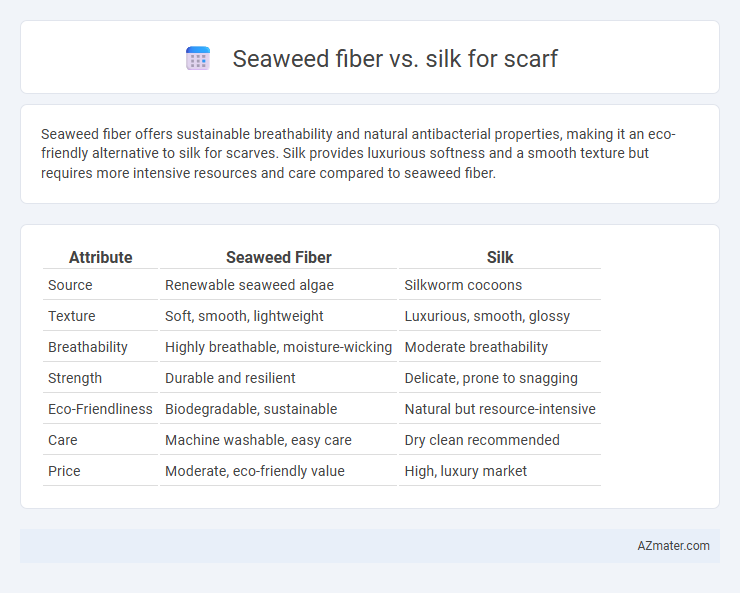Seaweed fiber offers sustainable breathability and natural antibacterial properties, making it an eco-friendly alternative to silk for scarves. Silk provides luxurious softness and a smooth texture but requires more intensive resources and care compared to seaweed fiber.
Table of Comparison
| Attribute | Seaweed Fiber | Silk |
|---|---|---|
| Source | Renewable seaweed algae | Silkworm cocoons |
| Texture | Soft, smooth, lightweight | Luxurious, smooth, glossy |
| Breathability | Highly breathable, moisture-wicking | Moderate breathability |
| Strength | Durable and resilient | Delicate, prone to snagging |
| Eco-Friendliness | Biodegradable, sustainable | Natural but resource-intensive |
| Care | Machine washable, easy care | Dry clean recommended |
| Price | Moderate, eco-friendly value | High, luxury market |
Introduction to Seaweed Fiber and Silk Scarves
Seaweed fiber, derived from natural seaweed algae, offers a sustainable and eco-friendly alternative to traditional textile materials for scarves, known for its softness, breathability, and antibacterial properties. Silk, a luxurious fabric produced by silkworms, is celebrated for its smooth texture, natural sheen, and excellent moisture-wicking abilities, making it a timeless choice for high-end scarves. Both seaweed fiber and silk provide unique tactile experiences and aesthetic qualities, catering to different preferences in scarf materials and environmental considerations.
Origins and Production Processes
Seaweed fiber, derived from sustainably harvested seaweed through a bio-extraction process, offers an eco-friendly alternative to traditional textiles, while silk originates from the cocoons of silkworms cultivated through sericulture. Seaweed fiber production involves enzymatic treatments to transform algae into a soft, biodegradable material, emphasizing renewable resources and reduced chemical usage. In contrast, silk production requires careful harvesting and spinning of silkworm fibers, often associated with labor-intensive practices and higher environmental impacts compared to seaweed fiber's innovative, plant-based methodology.
Texture and Feel: Seaweed Fiber vs Silk
Seaweed fiber scarves offer a unique silky-smooth texture with a gentle, natural sheen, providing a breathable and lightweight feel ideal for sensitive skin. Silk scarves deliver a classic luxurious softness with a lustrous surface and fluid drape, known for their cool, smooth touch and elegant appearance. Both materials excel in comfort, but seaweed fiber emphasizes eco-friendly freshness while silk highlights timeless sophistication.
Sustainability and Environmental Impact
Seaweed fiber for scarves offers a sustainable alternative by utilizing renewable marine resources that require minimal water and pesticides, reducing environmental strain compared to traditional silk production. Silk, derived from silkworms, involves intensive resource consumption and ethical concerns related to animal welfare, impacting its overall sustainability profile. Seaweed fiber's biodegradability and low carbon footprint make it an eco-friendlier choice in sustainable fashion compared to conventional silk fabrics.
Breathability and Moisture Management
Seaweed fiber scarves excel in breathability due to their natural cellulose structure, allowing better air circulation compared to silk's protein-based fibers. Moisture management in seaweed fiber is highly effective as it can absorb and release moisture quickly, keeping the skin dry and comfortable. In contrast, silk offers moderate breathability and moisture-wicking properties but tends to retain moisture longer, which may feel less refreshing in hot or humid conditions.
Durability and Wear Resistance
Seaweed fiber exhibits high durability and exceptional wear resistance due to its natural cellulose structure, making it a sturdy choice for scarves exposed to frequent use. Silk, while luxurious and smooth, tends to be more delicate and susceptible to abrasion and pilling over time, requiring careful handling to maintain its integrity. The inherent strength of seaweed fiber ensures longer lifespan and sustained appearance, surpassing silk in resilience for everyday wear.
Color and Dye Affinity
Seaweed fiber exhibits excellent color retention due to its high moisture absorption and natural affinity for dyes, resulting in vibrant and long-lasting hues suitable for scarves. Silk, prized for its smooth texture and protein structure, binds exceptionally well with a variety of dyes, yielding rich, deep colors and a luxurious finish. Both fibers offer distinctive dyeing properties, with seaweed fiber providing eco-friendly, bright colors while silk delivers a sophisticated sheen and color depth.
Skin Sensitivity and Hypoallergenic Properties
Seaweed fiber scarves offer a natural hypoallergenic option with antibacterial properties that help reduce skin irritation, making them ideal for sensitive skin. Silk scarves provide a smooth, breathable texture that is gentle on the skin but may cause allergic reactions in individuals sensitive to animal proteins. Both materials promote comfort, but seaweed fiber ranks higher in skin sensitivity compatibility due to its plant-based origin and antimicrobial benefits.
Price Comparison and Accessibility
Seaweed fiber scarves typically offer a more affordable price point compared to silk, making them accessible for a wider range of consumers looking for sustainable fashion options. While silk scarves are often priced higher due to the labor-intensive production and luxurious texture, seaweed fiber benefits from innovative manufacturing processes that reduce costs. Seaweed fiber is becoming increasingly available through eco-conscious retailers, whereas silk remains prevalent in traditional and luxury markets worldwide.
Choosing the Best Scarf: Seaweed Fiber or Silk?
Seaweed fiber scarves offer exceptional sustainability and natural antibacterial properties, making them ideal for eco-conscious consumers seeking comfort and durability. Silk scarves provide luxurious softness, vibrant sheen, and excellent breathability, appealing to those prioritizing elegance and traditional craftsmanship. Choosing between seaweed fiber and silk depends on whether one values environmental benefits and innovation or classic luxury and timeless style in their scarf selection.

Infographic: Seaweed fiber vs Silk for Scarf
 azmater.com
azmater.com